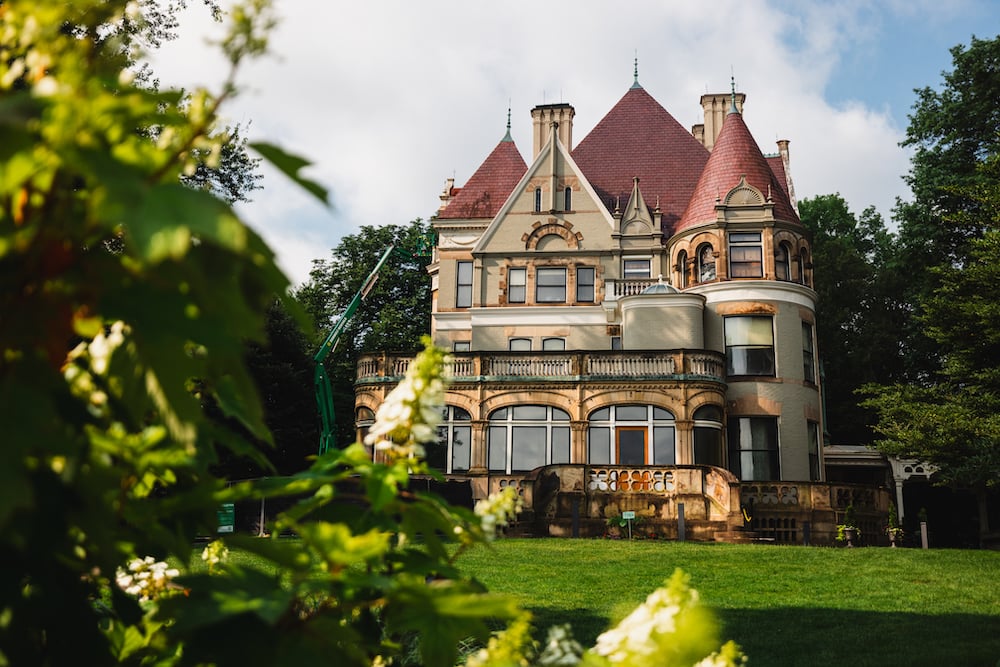Meet 5 Musical Greats from the Pittsburgh Jazz Legends Program
Thirty-two artists have been inducted into the program.

FROM LEFT: ETTA COX, DWAYNE DOLPHIN, NELSON HARRISON, ROGER HUMPHRIES, JAMES T. JOHNSON JR. | PHOTOS BY KAHMEELA ADAMS-FRIEDSON
One cannot mention Pittsburgh’s contributions to culture without including jazz. Even the casual jazz listener is familiar with the more prominent names that have come out of the Steel City: Billy Strayhorn, Mary Lou Willams, Ahmad Jamal and George Benson.
But oftentimes, we’re too quick to recognize the geniuses and talents of the past and not the achievements of more contemporary artists shaping new sounds and traditions.
Marty Ashby, MCG Jazz executive producer and vice president, defines jazz as having a “sense of groove that is deep and clear … based in blues.” Since 1987, the mission of Pittsburgh’s Manchester Craftsmen’s Guild has been to preserve, present and promote jazz — not just the music but also the history and education.
He says so many artists have gone unsung, so he wanted to change that.
Ashby and Bill Strickland, former president and CEO of Manchester Bidwell Corporation, in 2008 created the Pittsburgh Jazz Legends program, a sort of hall of fame to recognize jazz masters who stayed in Pittsburgh and kept the scene vibrant and thriving. Thirty-two artists have been inducted into this program thus far.
To mark Jazz Appreciation Month in April, here are five of those jazz legends.
The Performer
Etta Cox
Jazz vocalist Etta Cox was born in segregated St. Joseph, Missouri. She remembers having to sit in the back of the bus when her family traveled anywhere. “When integration came, we could sit any place on the bus that we wanted. My mother told us, ‘Don’t you ever sit in the back of the bus ever again,’” Cox recalls.
She never has since then. Cox not only vows to always be at the front of the bus, but she also upholds that confidence onstage.
“When she walks onstage, it just commands respect,” says Marty Ashby, MCG Jazz executive producer and vice president.
Her dad was a Baptist deacon, and her mother was a dietitian. She credits her sister, Florence, for giving her a little push to sing and perform. When Cox was little, her sister would come home from school and teach her what she had learned that day, like writing in cursive and simple songs. “I want you to know these songs because when you get to school, they’re going to know you’re my sister, and I don’t want them to think you’re dumb,” Cox recalls with a smile.
She performed in her first recital at age 6, singing and playing the piano. While attending Catholic grade school, Cox joined the choir with her high operatic voice and was introduced to Gregorian chants. “I thought this was the holiest, most beautiful music I’ve ever heard in my life,” Cox says. At 12, she started her formal vocal training, focusing mainly on classical music.
Cox came to Pittsburgh from St. Louis with her now-former husband, Tony Cox, after he took a job here. Not knowing anything about the Steel City, she made it clear that she wanted to sing when she arrived.
She soon met the man who would make that happen — jazz trombonist and bandleader Al Dowe, who also became her mentor and lifelong friend. Until then, Cox had sung showtunes, classical, Motown and Gregorian chants, but not jazz. “My father and mother owned one jazz record. And that was Dakota Staton, ‘The Late, Late Show,’” Cox says. “I memorized every song on it. But that was the only jazz I ever heard ’til I moved to Pittsburgh.”
Before she could officially join The Al Dowe Band, he gave her a crash course on some of the great female jazz vocalists, including Nancy Wilson, Sarah Vaughn and Ella Fitzgerald. It was Wilson singing “Guess Who I Saw Today” that grabbed hold of Cox. “Oh, my God, it was just like, something opened up for me. And I just fell in love with the music, the style, the freedom,” Cox says. It wouldn’t be long before she grew into the music.
Acting is another of her passions; she’s appeared in several Broadway productions, including “I Love My Wife” and “The 1940’s Radio Hour.” In film, Cox has performed alongside such actors as Russell Crowe and the late Christopher Reeve. She has kept Pittsburgh as her main address because of the community she has made. “I just never met the kind of people that I’ve met living in Pittsburgh,” Cox says.
She and Dowe owned and operated Dowe’s on Ninth, the spot for live jazz in Pittsburgh from 1999 to 2007. After Pittsburgh CAPA 6-12 moved in next door to Dowe’s in 2003, she started utilizing her degree in music education to teach young performers. Her CAPA courses cover jazz and vocal history, taking students on a vocal journey from the songs of enslaved Africans to blues and jazz and their connections to hip-hop.
“I don’t know why my name is so associated with jazz because it really wasn’t the front-runner in my life for a long time,” Cox says. “I’m just very grateful that I’m able, even to this day, to do the things that I really love, and to pass [music] on to another generation of people.”
The Funk Master
Dwayne Dolphin
Jazz and funk bassist Dwayne Dolphin started his musical journey as a child in the 1970s by banging on the drums. He switched his interests at age 11 when his older brother bought an electric bass guitar.
“He caught me playing his guitar,” Dolphin recalls about his brother. “He said, ‘You should get a bass.’ So the next day, he went out and bought me a bass for like 10 bucks. And I’ve been playing bass ever since.”
Dolphin credits listening to records as his first teacher. “The record that got me started was ‘Cannonball [Adderley Quintet at the Lighthouse].’ That was the first jazz record I ever took a hard listen to,” Dolphin says. But Dolphin is also a funk man. “I had a love affair with Parliament Funkadelic, everything that they played.”
When Pittsburgh bassist John Heard retired, he gave his big bass to Dolphin. Through that connection, Dolphin met jazz pianist and bandleader Hank Jones. Dolphin courageously asked for a favor: “I said, ‘Mr. Jones, if John is going to truly pass this torch, then, the first time I touch this bass, I want to play it with you.’” To Dolphin’s amazement, Jones agreed; some time later, Dolphin got the experience of a lifetime. “I learned that I knew absolutely nothing about jazz! I had to pull out records. I had to sit down and study because Hank Jones had the ability to speak a different language. And it was such a wonderful, humbling learning experience … it was breathtaking,” Dolphin says.
Dolphin already was lighting up the Pittsburgh jazz scene at age 15, working with drummer Roger Humphries and many of his local heroes. Word of Dolphin’s talents got around to Wynton Marsalis, who invited him to tour with his quintet; he even appeared with the band on “The Tonight Show with Johnny Carson.” Thankful for experience (and setting the glitz and glamour aside), Dolphin knew it wasn’t exactly what he was looking for. A few years later, he joined funky blues master Hank Crawford’s band, which proved to be the enlightenment he needed. “Hank is my college. He was my institution. I learned valuable things,” Dolphin says.
Dolphin makes sure to pay lessons forward when meeting younger musicians. “[Dolphin] is the prime example of carrying on the legacy of the sound of Pittsburgh. You know, he’s got a deep pocket. He cares deeply about passing on the legacy of the music,” Ashby says. Dolphin encourages young musicians to take advantage of the deep well of great talent here. “The best way to put it is, you’re seeking information in jazz, always go to the horse’s mouth,” Dolphin advises. “You ask a master about the music, he’s going to give you the correct answer the first time out.”
Still based in Pittsburgh, Dolphin continues to play throughout the city, including performances with the Pittsburgh Ballet Theatre and at Con Alma, a Downtown jazz club. One of the things he says he loves most about the Pittsburgh jazz sound is that it’s “blue-collar. Direct and to the point. Honest with soul!” Honest with soul — a phrase that could also describe Dolphin.
The Historian
Nelson Harrison
Being born in 1940 in Homewood undoubtedly led to Nelson Harrison’s embrace of Pittsburgh’s jazz scene. He keeps a meticulous record of the who, the what and the where in Pittsburgh’s jazz history. He was there to watch and make most of it happen. Harrison “cares deeply about the legacy and the history being told correctly,” Ashby says.
Harrison is known for inventing his one-of-a-kind trombetto, a 10-inch bass instrument with four valves. It can play six octaves chromatically through a trombone mouthpiece. A veteran of the Count Basie Orchestra, Harrison has composed more than 400 songs, including scores for national movies and plays. He’s played with Kenny Clarke, Billy Eckstine, Earl “Fatha” Hines and countless other heavy hitters of the genre, plus artists like Stevie Wonder and Liberace.
Harrison says one can get more from playing the music by feeling than by relying on sheet music. He demonstrates this by taking a piece of paper and shaking it in the air. “That’s the only sound sheet music makes,” he tells them. “The music’s got to come out of you.”
When he started, he and his bandmates would rehearse in the dark so the focus was on listening to each other rather than looking at the music. “We weren’t reading changes or nothing; we were listening to each other,” Harrison says. “So, when I pass that on to youngsters, I do the same thing to them. I say, ‘Close your eyes.’”
He was a trombonist and bandleader when he was just 13. Looking to earn some money, Harrison joined The Beethoven Bebops, a 13-piece band. He became its leader in a year and played his first night club. From there, a love of jazz was in his soul. By the time he got to college, he felt he was living in two worlds: He was a student at University of Pittsburgh Medical School but still performing around town, including at the former Crawford Grill in the Hill District.
Just after a gig at the Crawford Grill in 1964, Harrison had to turn down Art Blakey’s offer to play with him and The Jazz Messengers, a band he very much wanted to be a part of. “There’s only two bands in my life I wanted to play with: The Messengers and [Count] Basie. I said, ‘I’d love to, Art, but I’m in medical school.’ To which Blakey responded, ‘You ain’t no doctor … you a musician!’”
Harrison was getting similar pressure from his school advisers to choose a career. Even though he knew there could be very little money and even less respect in jazz, he refused to give up the music. “I loved it that much, and I still do,” he says. “I say it’s my religion now. Because I find God through jazz, I find all my spirituality through the music because of what it makes you become in order to do it right.” However, his grades suffered as he tried to do both, so he switched to clinical psychology.
“I always say music is mostly silence. When you play a note, you’re interrupting the silence,” says Harrison, who has a Ph.D. in clinical psychology and is a professor of psychology and ethnic studies at the Community College of Allegheny County. “Don’t interrupt the silence unless you’re bringing something beautiful or meaningful. Otherwise, leave it alone.”
The Musician’s Musician
Roger Humphries
Drummer Roger Humphries was born to make music. His uncles, Frank and Hildred Humphries, would have jam sessions with fellow Pittsburgh jazz drummer and bandleader Art Blakey. His older brothers Lawrence and Norman were also musicians, so his home was filled with musical instruments that were ready to be explored.
Humphries is the youngest of 10 children, all of whom loved music. He looked forward to the weekends when everyone was home from school, and “the music would start immediately with the record player.” The family would listen to artists like Mahalia Jackson, Dinah Washington, Sarah Vaughan, Art Blakey and Max Roach. Today, Humphries lives just across the street from his childhood home in the Mexican War Streets. In 2024, the city renamed that street — East Jefferson — “Roger Humphries Way.”
When Norman held a band rehearsal at their parents’ home, a 4-year-old Humphries “started beating on things.” Recognizing his interest, his brother began to show him moves on the drums, like the single stroke. Young Humphries would imitate what he was being shown.
“If somebody plays something for you, and you can imitate it, it’s inside of you, and you break it down in your brain,” Humphries says. “Music is to me … like a language. [My brother] would start playing different things I can imitate, you know before I could even think about reading anything.” Visitors to the Charles “Teenie” Harris photography exhibit at the Carnegie Museum of Art can see his image of a young Humphries playing a pint-sized drum kit in 1948 in a music classroom.
By age 14, Humphries began playing in local jazz clubs. At 16, Humphries led an ensemble at Carnegie Music Hall in Oakland. He began touring at age 18, notably with Stanley Turrentine and Shirley Scott. He built a reputation as a masterful musician, providing the rhythmic beat for Geri Alan, Richard Groove Holmes, Horace Silver and even Ray Charles, to name a few.
Although Humphries never took formal lessons, he feels that his time with bands and on the road gave him “a million dollars worth of education.”
Now in his 80s, he’s pretty low-key about the ripples he has made in the jazz world. According to Ashby, whenever musicians from around the world come to play at MCG Jazz, one of their first questions is, “Where is Roger Humphries?” He has made a lasting impression on many, yet he’s extremely humble.
“See, that’s the thing that makes him so, so wonderful. I mean, he’s real,” Dolphin says about Humphries. “There’s nothing pretentious about him. He’s just a beautiful cat, man.”
After playing for audiences all over the U.S. and Europe, Humphries eventually decided to stay put in Pittsburgh to spend more quality time with his family. He and his band, The RH Factor, still play around Pittsburgh. He has also taught at Pittsburgh CAPA, University of Pittsburgh and Duquesne University, molding new generations of musicians.
And in late February, Humphries was named to the inaugural class of Jazz Legacy Fellows, which honors 20 jazz legends from around the country. It comes with an unrestricted grant of $100,000 from the Andrew W. Mellon Foundation.
The Educator
James T. Johnson Jr.
Born in 1949 in Paris, Tennessee, James T. Johnson Jr. came to Pittsburgh to continue his education in ethnomusicology, with an emphasis in jazz. His father was a minister and active leader with the NAACP, while his mother was a classically trained pianist and college professor. Because of his father’s association with the Christian Methodist Episcopal church, the family moved frequently, living in such places as Jackson and Nashville, Tennessee; and Shreveport, Louisiana.
The musical influences of his childhood involved his mother playing Chopin and listening to Nat King Cole. “My attention was captured through listening to [Cole] and later on, I was really … attracted by his piano playing,” he says. When Johnson found his mother’s old violin in the attic, he wanted to learn to play it. Johnson also took classical piano lessons while in elementary school. “I learned violin in a very short period of time, but nothing took my attention like the jazz piano,” Johnson says. His skills on the violin, however, earned him a college scholarship.
While attending Grambling State University in Louisiana, Johnson was selected by the Institute for Black American Music in Chicago, led by Quincy Jones, to participate in a program that offered concerts and workshops with some of the great musicians at the time. During one of these
workshops, he shared a jazz session with Herbie Hancock. “When I started playing jazz, I started getting serious about life,” he says. “Jazz turned my life around … I was saved by jazz.”
By then, Johnson had heard about Pittsburgh and its musicians. In 1977, he and his wife, Pamela, moved to the Steel City to continue his musical education in and outside the classroom. He taught at the University of Pittsburgh, Wright State University in Ohio, Duquesne University and Community College of Allegheny County and then with Pamela founded the Afro-American Music Institute in Homewood.
Since 1982, the couple — affectionately called Uncle James and Aunt Pam by the students — have significantly impacted the community, providing educational and therapeutic opportunities for students. Jazz is taught through various methods, including playing by ear and notation. Life lessons and history on the Black experience are weaved throughout the curriculum to foster a sense of family and support among students.
Johnson credits the support of his community for keeping the Institute strong for more than 40 years. Many graduates from the Afro-American Music Institute have made considerable contributions to the music industry, he says. Ashby admires Johnson and “his ability to persevere with his school for 40 years and continue to pass the torch and the spirit and the profound professionalism that he represents in the music. He and Pam are my heroes.”
Johnson, who has a Ph.D in ethnomusicology from Pitt, aims to positively impact young people’s lives every day.
“When you talk to elder musicians in Pittsburgh, the future of jazz in Pittsburgh varies,” he says. “I’m pretty sure that the present-day jazz scene is being compared to the earlier days among some elder musicians; however, when I travel to many of our major cities, I find that Pittsburgh is ahead of the curve, especially among middle-aged and younger musicians.”
Which artists have been inducted into the Pittsburgh Jazz Legends program?
- Harold Betters
- James Johnson Jr.
- Don Aliquo Sr.
- Nelson Harrison
- Joe Dallas
- Joe Negri
- Etta Cox
- Frank Cunimondo
- Roger Humphries
- Art Nance
- Michele Bensen
- George “Duke” Spaulding
- Al Dowe
- James Guerra
- Kenny Blake
- Cecil Brooks Ii
- J. Warren Watson
- John Wilson
- Harry Clark
- Kenneth Cook
- Dwayne Dolphin
- Ray A. Defade
- George Jones
- Max Leake
- Chuck Spatafore
- Lou Stellute
- Mark Strickland
- Mike Tomaro
- Tony Campbell
- Marva Josie
- Eric Johnson
- Eric Susoeff
The Pittsburgh International Jazz Festival celebrates its 15th year Sept. 18-21 at the August Wilson African American Cultural Center. The New York City-based Mellon Foundation recently provided a $4 million grant for the event.
Kahmeela Adams-Friedson, who curates Pittsburgh Magazine’s cultural listings in N’at, brings particular expertise in all things ’80s, ’90s and horror movies. Her opinions on life, film and literature can be found in several podcasts and publications.
















